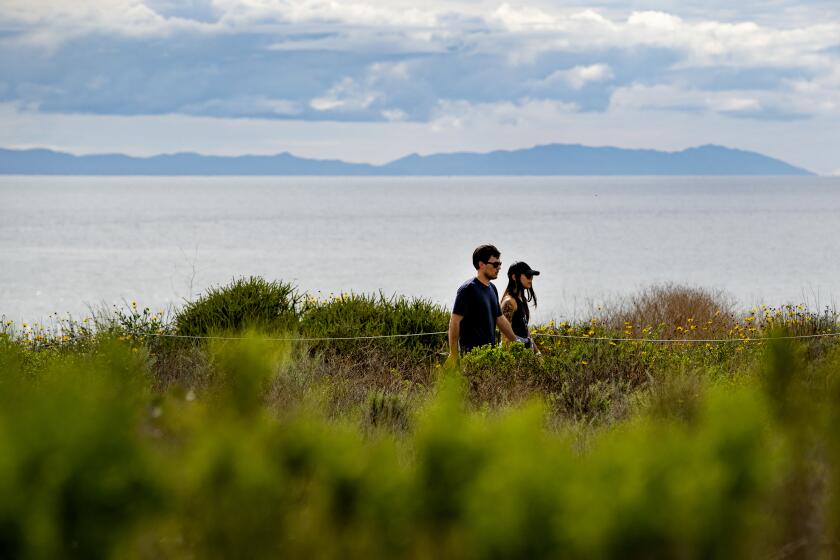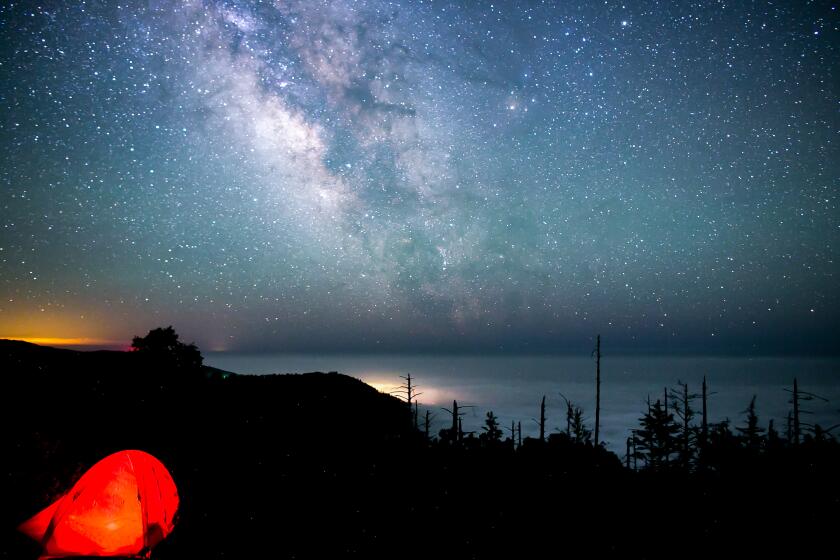Crafting a Visit to the Mexico of Another Era : Folk-art tours visit villages where artisans observe time-honored traditions.
The bus labored up the steep, deeply rutted dirt road to Ocumicho until our driver Antonio finally gave up, fearful of stranding a 40-foot-long motor coach hours away from the nearest paved highway.
With good-humored aplomb, he had negotiated our bus through tire-sucking mud puddles, herds of cows and goats filling the roadway, and tiny villages with streets so narrow that the bus almost knocked plaster off the adobe buildings as it squeezed past.
But this was it.
The bus door hissed open and we clambered out.
“Por aqui! Por aqui!” (This way! This way!) shouted Emilio Basilio, an Ocumicho villager who smiled broadly as he stood at the top of a hill and waved us to his home.
In we marched to his dirt-floored, wood-and-adobe dwelling, more a lean-to than a house. The family laundry hung on a clothesline in back. Chickens pecked at corncobs lying in the yard. Smoke drifted out of another small wooden building where the slap, slap, slap of someone making tortillas could be heard.
And against the wall stood the reason for our trip: ocumichos .
Before us were thrust clay figures of grinning red and blue devils on motorcycles and taxis, lady skeletons in ornate flowered skirts and Christ figures bedecked from top to bottom with tiny cherub faces.
An acquired taste, such pieces used to fetch a few dollars in Mexican curio stores. But now, signed by their makers--Purepacha Indians such as Basilio--they carry the upgraded label of folk art, with price tags to prove it. Exclusive Southwest design stores in cities such as Houston, Scottsdale, Ariz., and Los Angeles sell the work for hundreds of dollars.
For our group of 14 who traveled to the heart of Mexico to meet dozens of folk artists, the price was still a bargain.
But it wasn’t price alone that brought us. It was to see a Mexico that many think no longer exists. A Mexico of tiny villages where Indian dialects are spoken, native crafts are still practiced and centuries-old customs are still observed.
Such tours are the specialty of Rocky Behr, 63, owner of The Folk Tree store in Pasadena. A former school psychologist in the East San Gabriel Valley, Behr fell in love with Mexico and its artisans during more than 25 years of travel. She filled her Pasadena home to bursting with wood carvings, pottery and graphics, until they spilled over into her shop, opened six years ago on South Fair Oaks Avenue.
She started The Folk Tree tours three years ago, as an extension of her five or six buying trips south each year. She now leads three very personalized tours annually to the states of Oaxaca, Jalisco and Michoacan.
A tall, practical and efficient woman given to wearing socks and Birkenstocks and 100% designer cotton T-shirts with matching pants while traveling, Behr is at heart a romantic.
“I wish time could have stood still in the 1960s,” she confessed during a taxi ride from Tonala, a small village outside Guadalajara, into town. “It was a different Mexico.”
The gleamingly modern, state-created beach resorts of Ixtapa and Cabo San Lucas are not for Behr, nor is the posh Hotel Camino Real chain throughout Mexico. Instead, Behr’s tour introduced us to charmingly eccentric hotels with uncertain hot water; drives through lush mountain countryside filled with wildflowers and prickly pear cactus; artisans whose homes ranged from one-room shacks to architecturally splendid estates; expatriate Americans running art studios and textile factories, and village festivals where our small group of Americans stood out from the crowds of shawl-wearing Indians from neighboring villages.
“It’s like a dream,” said Anne Ottewill, a tour member from Kansas who was surprised by a local parade that rounded a corner in Uruapan one Monday afternoon and engulfed our bus.
“You go in and out of these bizarre experiences,” she said. “You’re in one place and then you’re in another. It’s like a carnival.”
The carnival-like atmosphere came, in part, from Behr’s jampacked tour schedule. Our group had barely checked into our hotel in Guadalajara after the flight from Los Angeles when we headed for Tonala in a caravan of taxis.
The next day it was an early rise to board a chartered bus that would be our second home for the next 12 days as we traveled what is known as the “Colonial Circle”--from Guadalajara to Guanajuato and San Miguel de Allende.
Towns along this route, the heartland of the 1810 Revolution of Independence, are known for their colonial architecture and crafts. But while other tours take in the expected--main plaza, market, shops, church and ruins--Behr had Antonio drive to events such as the sawdust fair in tiny Patamban in the state of Michoacan.
Patamban, noted for its distinct pottery of large glazed, green pineapple vases, holds a yearly festival the last Sunday in October, when we visited. We found hundreds of people filling the village to peer at the cobblestone streets and a two-foot-wide swath of sawdust in the middle over which the townspeople toiled. On top of this first layer, Patamban residents carefully applied more sawdust dyed bright red, purple, green, orange and yellow. Whole flowers, flower petals, leaves and ferns were also put down in intricate abstract designs or in images of birds, hearts, crosses and angels.
Overhead, garlands of colored paper, straw and paper cups waved in the breeze. Arches at some intersections bore a rainbow of attached pottery, paper bows and even marshmallows. The smell of fresh pine needles carpeting the street beside the sawdust mingled with the odor of grilled meat and onions from dozens of food vendors cooking outdoors.
“I’ve been doing this since I was a little child,” said Patamban resident Juana Contrera as she lugged a bag of pine needles from her house. “It’s not a contest. We do it in honor of Christ the King.”
Similarly stunning was the gathering in Patzcuaro, a 16th-Century city and former capital of the pre-Colonial Purepacha Indian empire. The town sits at an altitude of 7,200 feet near the shores of 13-mile-long Lake Patzcuaro.
Although the lake’s fishermen, with their distinctive butterfly nets, are a well-known Mexican image and its small white fish a delicacy, the lake has been fished out for years. The boats set out only for photographers. The fish come from farms.
But we had come, not for the lake but for the Day of the Dead Festival, held annually Nov. 2. Tiny Patzcuaro has only 3,000 residents, but it draws hundreds of folk artists from throughout Mexico who fill the plaza with their pottery, wood carvings, jewelry, clothing and other crafts. During the chilly nights, some vendors wrap themselves in blankets and sleep on the sidewalk under the porticos of buildings surrounding the plaza.
One morning, as I crossed the plaza for my morning cappuccino at one of the half-dozen restaurants that offer it, I was startled to see Basilio waving to me from a huddle of blankets and bodies. He and his family had carted their ocumichos to Paztcuaro to sell, and now greeted us like old friends. Later, he handed me three little devil faces that I had paid for and forgotten in his house.
We spent four nights in Patzcuaro at the Hotel Los Escudos, a small, two-story, colonial-style hotel fronting the town’s main plaza. Lodgings varied from room to room. Some rooms were windowless but had wood-burning fireplaces. Others boasted balconies overlooking the plaza. Mine had shower windows that opened to an interior walkway--and passing hotel guests.
“Oh good, we can talk to our friends while we shower,” my roommate joked.
Whatever their design, all the rooms were booked months ahead. The festival draws hundreds of visitors: wealthy Texas matrons shopping for folk art, backpack-toting youths looking for bargain-rate fun, and professional photographers and filmmakers seeking to document the Day of the Dead observance there.
In honor of the dead, many Patzcuaro shops and homes put up ofrendas , home altars honoring spirits of the departed. We gained a deeper understanding of this custom at a reception given one evening at Patzcuaro’s regional art museum by chic Rafaela Luft, daughter of the museum’s former director, Teresa Davalos, who died six years ago. Under Davalos’ guidance, the museum grew from a simple collection of folk art housed in a 16th-Century college building to a repository preserving irreplaceable antique examples of now-extinct Mexican craftsmanship.
With tears in her eyes, Luft spoke of her mother’s work as she stood beside the ofrenda . Decorated with the bright marigold flowers, incense and candles typical of the region, the altar also contained a photo of Luft’s mother and her shawls and jewelry, plus pastries and a bottle of anis favored by her mother.
“Usually, the museum just has a display ofrenda,” Luft said. “But this year, I wanted to do something special.”
This feeling of “something special” occurred repeatedly throughout the tour.
In Santa Clara de Cobre, Mexico’s copper-ware capital, we toured a copper crafts school set up by sculptor James Metcalf. Afterward, the New York-born expatriate unexpectedly invited us to his new home, still under construction on a hill above town.
“I copied my studio in Paris, except I made it bigger,” Metcalf said. “But it never occurred to me that living in the tropics, the light would be different, so it’s not facing the right direction six months of the year.”
It was a minor imperfection in a house flooded with sunlight from the skylights overhead and dominated by a dramatic, walk-in-sized fireplace. The house sat behind thick adobe walls that surrounded flowering pear and quince trees among which woolly sheep grazed.
In Capula, Juan Torres let us wander through his equally stunning custom-designed home perched on a grassy slope overlooking blue mountains in the distance and his ceramics workshop below. A graphic artist from nearby Morelia, Torres moved to tiny Capula, where he teaches ceramics to preserve the regional crafts, provide work for the villagers and keep them from leaving for manual labor in the United States.
“You look so peaceful and content out here,” I told him.
“Yes, but inside, much torment,” Torres said, displaying his paintings of the bloody and nail-studded hand of Christ.
Yet the tour was not all artists and their crafts. It included its share of ruins, cathedrals and gourmet restaurants. In Tonala, we sampled hot avocado consume at Los Geranios restaurant. In Zamora, at the Maison San Fernando, a hacienda-styled restaurant with outdoor tables surrounding a fountain, we wolfed down appetizers of baby broiled potatoes spiced with chewy dried red chiles. The potatoes nearly overshadowed the house specialty: a shredded, marinated chicken served piping hot in molcajetes --black volcanic rock dishes used to grind chiles.
We also dined at Fonda Las Mercedes, an artist hangout in Morelia where paintings for sale adorn the walls and complement dishes such as trout and pasta with pine nuts.
By the time of our farewell meal in San Miguel de Allende at La Vendimia--whose chef and owner, Jack Jesse, trained at 72 Market Street in Venice--we had nearly forgotten that we all lead lives elsewhere, outside of Mexico and its culture, customs and people.
“It’s a people-to-people kind of thing,” Behr said of her tours. “I like letting people see the real Mexico to appreciate the culture.”
GUIDEBOOK: Finding Folk Art in Mexico
Getting there: The Folk Tree offers three Mexico tours a year, two to Oaxaca (May 19-30 and Dec. 27-Jan. 7, 1993) and a Day of the Dead tour to Michoacan (Oct. 22-Nov. 3). Tours are priced at $2,150 per person, double occupancy ($2,350 for singles), including round-trip air fare from Los Angeles to Guadalajara, chartered bus and taxis used on tour outings, accommodations, 11 meals and tips. Tours are kept to under 20 people. This year’s Michoacan tour is being sponsored by the Southwest Museum (address below). Contact Rocky Behr or Kathi Oshima at The Folk Tree, 217 S. Fair Oaks Ave., Pasadena, (818) 795-8733, for information on all three tours.
Other craft tours: The Southwest Museum sponsors three to five tours a year in North America, focusing on native arts and culture. The tours require joining the museum and range from three to 12 days and $500-$2,500 in cost, including air fare, hotels, admission fees, most meals and ground transportation. Contact Lynn Kirst, director of development, Southwest Museum, P.O. Box 41558, Los Angeles 900041-0558, (213) 221-2164.
The Los Angeles Craft and Folk Art Museum offers four tours a year, including one outside the country, to museum members or associate members. Trips this year include Guadalajara, April 30-May 3, for $795, including air fare, hotel accommodations, most meals and ground transportation. Contact Sue Sirkus, director of development, Craft and Folk Art Museum, 6067 Wilshire Blvd., Los Angeles 90036, (213)-937-5544.
Raoul De la Sota, professor of Mexican art history at Los Angeles City College, conducts one trip yearly that is open to the public for college credit. This year’s Easter break trip to Chiapas and the Yucatan in Mexico is fully booked, but De la Sota is planning a trip to Spain in January, 1993. Contact De la Sota at the International Education Program, Los Angeles City College, 855 N. Vermont Ave., Los Angeles 90029, (213) 255-9913.
Sign up for The Wild
We’ll help you find the best places to hike, bike and run, as well as the perfect silent spots for meditation and yoga.
You may occasionally receive promotional content from the Los Angeles Times.



